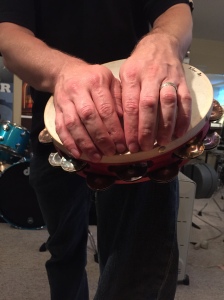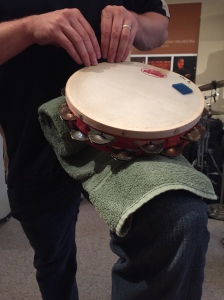In the last installment of this series I’m going to tackle the tambourine. I think I’ve got some pretty good tips for good tambourine playing but I’ve found that a lot of success can come from just experimenting with angles and different methods of playing. Try my tips to see if they work but I’d really encourage you to experiment and find your own solutions.
Holding the tambourine
The typical thought process as to which hand to hold the tambourine with is to use your non-dominate hand. This will allow your dominate hand to play rhythms on the shell or head of the tambourine. The grip should be as similar to a drum stick grip as you can (considering you are holding a round object…) Similar to a drum stick grip, you want as much of your hand in a neutral position as possible. The least amount of tension the better.
Most playing will be done with the tambourine at a 45 degree angle. This allows some jingle ring but also give a reasonable amount of clarity. For lots of clarity, hold the tambourine parallel to the floor. For lots of jingle ring (like in a roll), hold it at a 90 degree angle to the floor. Experimenting with different angles in different musical contexts can be fun and give you better musical results.
The head
It is very quickly forgotten that the tambourine has a head attached to it. There is your Captain Obvious statement of the day. Just like a snare drum we may want to change the resonance of that head – make it drier or let it ring. This is all well and good but we want to remember that whatever we choose, we most likely want that to remain consistent throughout. You wouldn’t add some more muffle during a soft passage of a Delecluse étude and then take it off for a loud roll. The tambour would chance so much that it would confuse the listener. The same is true of tambourine. This problem generally occurs when transitioning from soft to loud playing or vice versa. This can be overcome by paying VERY close attention to your palm, arm, and fingers to make sure they are (or are not) touching the head when you want them to. I have found moongels work great to solve this problem. Just like a snare drum muffle, they keep the head sounding consistent. And I’ve virtually never had a problem of one flying off!
Playing rhythms
Similar to my triangle playing, I try to play as much of the rhythms I can using one hand. If I want a very clear rhythm I will stay very close to the edge, if not right on the edge. If I want more head “pop”, I will move closer to the center of the head. For super soft dynamics I use one finger and the louder the dynamics get I will add more. I will also add more wrist and eventually arm as the dynamic range gets larger. I generally don’t use my entire fist unless I am really trying to cut through the ensemble at a loud dynamic level. Playing with the fist has a great pop to it which can cut, but I save that for only the loudest of situations.
Playing rhythms with one hand is obviously not always possible and faster rhythms needed to be played with either 2 hands or a combination of hand and leg. Here are several solutions when using two hands.
When needing to using your hand and leg (note I say leg) here are some more options.
The reason I don’t always use my knee is because the knee tends to give the tambourine sound a big pop, which isn’t always wanted. We want our rhythms to sound consistent, so we want the “hand” sound to match the “leg” sound.
Tambourine rolls
The two tambourine rolls we use are a shake roll and a thumb roll. I actually don’t use the thumb for a “thumb roll” but the concept is still the same. I use my middle finger at about a 45 degree angle to the tambourine head and slide it across the head to make the tambourine and jingles vibrate. I use the middle finger because this is typical what I use to play rhythms with, making the transition between rolls and rhythms much easier. To make the roll easier I apply bass rosin to the head. A lot of people use beeswax for this which is fine. I use rosin because I just happen to prefer it and it’s an easy commodity to find at an orchestra rehearsal if you lose yours!
The shake roll is one of the most difficult parts of playing the tambourine in my experience. For some this comes easy but I have had to really work at it. There are two techniques used to accomplish the shake roll. The goal of both is to have the most sustained sound possible. The first is to rotate the arm similar to if you were twisting a door knob very quickly. The other is to hold the tambourine above the elbow and rotate the elbow back and forth. The key to both techniques is to try and get the tambourine to move in three dimensions rather than just two. Shake rolls that sound rhythmic tend to be very side to side and only in 2 dimensions. This helps keep the jingles in constant motion, leading to a more sustained sound.
An exercise I use to work on this is to put a tambourine in both hands and go back and forth playing a roll. Generally one hand does one aspect better than the other, and each hand can teach the other. This also allows one hand to recover as the other is rolling. This is a very physical technique after all. I find this very simple exercise very useful when trying to iron out my roll.
Well that’s it for this series. I hope it was helpful in finding ways to improve your playing. I’ve got a few more ideas up my sleeve for the weeks ahead, but let me know if there is something specific you would like to see here. Been loving the comments!
WJ
Thanks again to my lovely wife for taking these photos.










nice article. the key point is in the introduction, especially as it relates to tambourine: experiment!
Great article, Will! This is all extremely useful!
Thanks everyone! It’s amazing solutions you can find when you are just messing around!
Excellent information and well written…bravo Will!
[…] ↑ https://williamjamespercussion.com/2015/04/19/technique-improvement-and-maintenance-my-warm-up-routi… […]